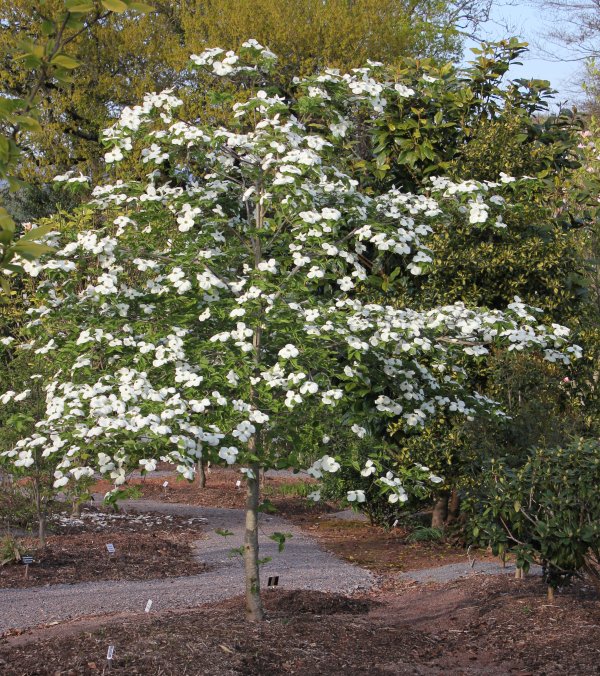
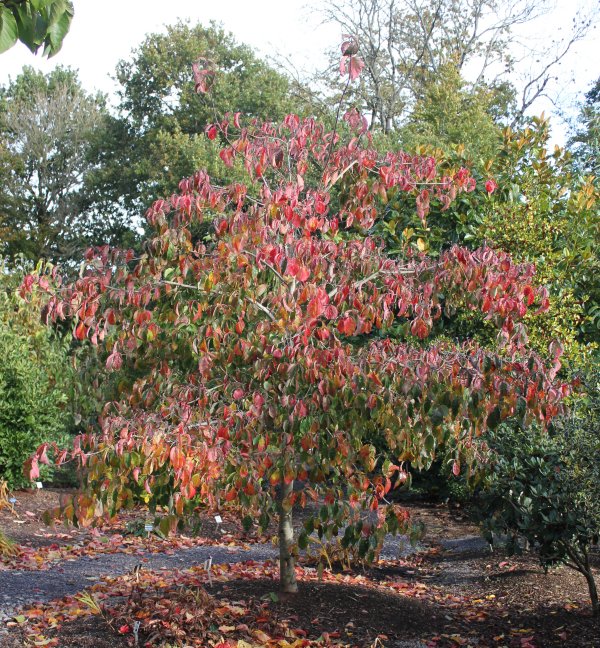
CORNUS...
last updated
18/11/2023
|
In its native distribution down through western North America, Cornus nuttallii is often found as a forest understory plant where it will typically have become a tall, rangy tree with a small crown. By contrast, specimens growing in good sunlight will have a shorter trunk and much more rounded, fuller canopy. Hence it's fair to say that although it will grow perfectly happy in even dense shade, it will make a more ornamental specimen in good light. Cornus nuttallii is the first species amongst our group of flowering dogwoods to flower in the year. Having enjoyed the buds all winter, for me it's one of the heralds of spring to see them unfurl and expand, to be at their best in April. Most of the dogwoods of this type have 4 bracts, but in my experience most cultivars of C. nuttallii have 5 bracts, though supposedly up to 8 are possible. When conditions are to their liking, it is common for plants of C. nuttallii to produce a second flush of bracts in the autumn. This often happens here, but it's a trait which does not appear to be shared by its hybrids. Few selections of Cornus nuttallii develop remarkable autumn colours here, usually being soft yellow and peachy tones. It may be the case that it requires a different climate (ie hotter summers and / or colder autumns, to colour to their potential. However, that of its hybrids are spectacular and some of the best, in shades of reds and oranges. Fruit is seldom set on any of them in our conditions here. It is unfortunate that C. nuttallii as a species does not seem to easily thrive in the British climate when grown from seed on its own roots. As a result we graft the cultivars onto the more robust and tolerant rootstock, Cornus kousa or its var. chinensis.
|
Cornus 'Pink Blush'
showing the early stage of its floral display in April (below left) and
its fabulous autumn colours (below right). |
 |
|
|
||
|
||
|
|
||
| Cornus
nuttallii 'Colrigo Giant' This vigorous American form was named after the Columbia River Gorge in which it was discovered. It is a splendid small tree of upright habit; supposedly having enormous flower heads, up to 15cm across, though ours have never achieved that size in our conditions. Nevertheless, the bracts in this cultivar expand to overlap, creating a more rounded head than in the other selections we grow. |
||
|
|
||
| Cornus
nuttallii 'Gold Spot' In this form, the leaves are spotted with gold. I have to admit that it's not an effect that I like. To my eyes, the foliage just looks unhappy, so we no longer propagate it. |
||
|
|
||
| Cornus
nuttallii 'Monarch' A selected form of broader, rather layered, habit, with large rounded flower bracts and purplish young shoots. Stunning bright red autumn colour. |
||
|
|
||
| Cornus
nuttallii 'North Star' A statuesque form of upright habit with large flower bracts and dark purple young shoots. The bracts do not expand to overlap, creating a star like effect. |
||
|
|
||
| Cornus
nuttallii 'Portlemouth' This first occurred in a garden near Salcombe, Devon. I've not seen the original specimen, but we find it to be a stout shrubby plant and not a particularly good doer. As a result it is something that we no longer propagate although we still have it in the collection (for the time being...) |
||
|
|
||
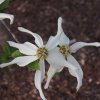 |
Cornus
nuttallii 'Zurico' A floriferous recent selection forming narrow star-like bracts. The branch structure is comparatively upright, though it forms a rounder silhouette than 'North Star'. See it in our Woodland Walk. |
|
|
|
||
|
||
|
|
||
| Cornus
'Ascona ' (C. florida x C. nuttallii) A small tree with gently pendulous branches. Thus it becomes clothed down to the ground with large white bracts in April. Vivid red and orange autumn colours. |
||
|
|
||

|
Cornus
'Cobhay Titan' This is an exceptionally strong seedling from Cornus 'Pink Blush' of our own breeding. It shows a greater influence from its C. nuttallii parentage and larger flowers, often with additional segments. It is typical of this group that the flower buds for the following spring are clearly visible as far ahead as the previous autumn. You can see one such bud on the photo of autumn leaf colour left. It's fun to watch them with great anticipation through the winter. It's a sign that spring is just around the corner when the bracts start to expand. |
|
|
|
||
 |
Cornus
'Dorothy' (C. florida x C. nuttallii) I am indebted to Talon Buchholz for sharing this magical plant with me. He introduced it as part of his Flora Wonder(tm) Collection of Buchholz Nursery where it forms a small tree to some 10' in 10 years. There are other well-known hybrids between these two parents of course, but they all sit happily at the nuttallii end of the scale. This one by contrast appears much closer to its florida parentage. The showy bracts are soft white near the centre with a warm pink edge. Fabulous autumn colours can be the reddest of all the selections in this group. See it in our Woodland Walk. |
|
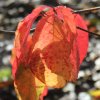 |
||
|
|
||
| Cornus
'Eddies White Wonder' (C. florida x C. nuttallii) Just to further confuse matters, there are two forms of this popular plant. We offer the true American form, which is similar to C. 'Ascona' with its lightly pendulous habit. (The other is much more upright.) The large white flower bracts and fantastic red and orange autumn colours are as typical for the group. |
||
|
|
||
| Cornus
'Ormonde' (C. florida x C. nuttallii) A handsome broad, small tree with the requisite large creamy-white flower bracts. Superb orange-red autumn colours. |
||
|
|
||
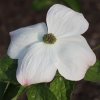 |
Cornus
'Pink Blush' (C. nuttallii x C. florida var. rubra) This is a fantastic American hybrid dogwood. It pleasingly rapidly forms a symmetrical small tree and produces masses of large flower bracts. These are almost pure white by the time they are mature, before becoming increasingly pink-blushed, darkening with age. It has fabulous autumn colours too. This is a personal favourite of mine, providing as it does spectacular multi-season interest. I also love its symmetrical habit. See also the photos at the top of the page. I mentioned in the introduction to "Cornus nuttallii, its cultivars and hybrids" above, how much I enjoy watching the buds through the winter. The photo below left captures one of those buds in the autumn. So this image was taken in October, and it will be April before this little bud develops into a flower head such as the one above it. If you look carefully at the photo of the bud, it's possible to discern the tight buds of the true flowers in the middle, subtended by 4 triangles. It is remarkable to think that the latter will enlarge to become the 4 bracts as in the upper photo, whilst the true flowers in the middle remain tiny. See it in our Woodland Walk. |
|
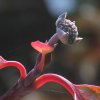 |
||
|
|
||
|
||
|
|
||
| Cornus
'Saudade' (C. kousa x C. nuttallii) This came to us as a cultivar of Cornus kousa. However, having grown it for a few years, I have become convinced that it is a hybrid with Cornus nuttallii. It produces enormous white bracts earlier in the year than any cultivar of C. kousa, and they are much larger too. The vigorous, open, tree-like habit is also more reminiscent of C. nuttallii whilst the autumn colours are exceptional. However you want to classify this one, it's a wonderful selection and I am very much looking forward to watching our specimens develop. |
||
|
|
||
| Back to Previous Page |